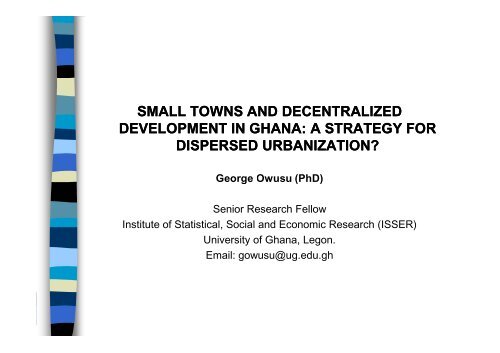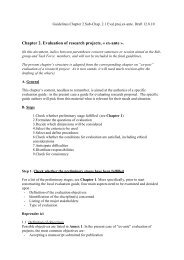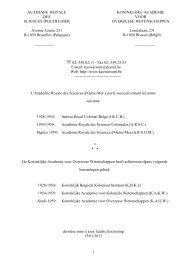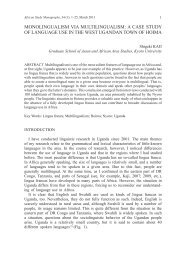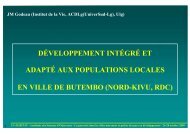small towns and decentralized development in ghana
small towns and decentralized development in ghana
small towns and decentralized development in ghana
Create successful ePaper yourself
Turn your PDF publications into a flip-book with our unique Google optimized e-Paper software.
SMALL TOWNS AND DECENTRALIZED<br />
DEVELOPMENT IN GHANA: A STRATEGY FOR<br />
DISPERSED URBANIZATION?<br />
George Owusu (PhD)<br />
Senior Research Fellow<br />
Institute of Statistical, Social <strong>and</strong> Economic Research (ISSER)<br />
University of Ghana, Legon.<br />
Email: gowusu@ug.edu.gh
Presentation Outl<strong>in</strong>e<br />
� Introduction<br />
� Ghana’s Urban System <strong>and</strong> Small Towns<br />
� Decentralization, Small Towns <strong>and</strong> Poverty Reduction<br />
� Decentralization <strong>and</strong> Dispersed Urbanization <strong>in</strong><br />
Ghana<br />
� Conclusion <strong>and</strong> Policy Implications
Introduction<br />
� Rapid urbanization <strong>and</strong> urban growth, especially the<br />
emergence of large cities, are creat<strong>in</strong>g serious<br />
challenges <strong>in</strong> Ghana:<br />
� <strong>in</strong>creas<strong>in</strong>g urban poverty <strong>and</strong> <strong>development</strong> of slums<br />
�� rapid conversion of agriculture l<strong>and</strong>s <strong>in</strong>to residential<br />
use<br />
� poor sanitation <strong>and</strong> waste management<br />
� Hous<strong>in</strong>g shortage <strong>and</strong> high accommodation/rent costs<br />
� traffic congestion, etc
Ghana: Total Population <strong>and</strong> Percentage Urbanized, 1921-2010<br />
Year Total Population* Percentage Urbanized<br />
1921<br />
1931<br />
1948<br />
1960<br />
1970<br />
1984<br />
2000<br />
**2007<br />
**2010<br />
2,298,000<br />
3,163,000<br />
4,118,000<br />
6,727,000<br />
8,559,000<br />
12,296,000<br />
18,912,000<br />
23,000,000<br />
23,458,000<br />
7.8<br />
9.4<br />
12.9<br />
23.1<br />
28.9<br />
32.0<br />
43.8<br />
49.0<br />
51.0<br />
* Population figures rounded to the nearest thous<strong>and</strong><br />
**Based projections (UNFPA 2007; GSS 2005).<br />
Source: Derived from Ghana Statistical Service report (2005a, 2005b)
Population Size of the Fifteen Largest Urban Centers, 1970-2000<br />
Town/City<br />
Bawku<br />
Agona Swedru<br />
Ashiaman<br />
Nkawkaw<br />
Sunyani<br />
Ho<br />
Obuasi<br />
Koforidua<br />
Cape Coast<br />
Tema Municipality<br />
Sekondi Sub-metropolis<br />
Takoradi Sub-metropolis<br />
Tamale Metropolis<br />
Kumasi Metropolis<br />
Accra Metropolis<br />
Total<br />
Source: Ghana Statistical Service (2005a, p. 130).<br />
Population Contribution to Urban<br />
Growth<br />
1970 1984 2000 1970-1984 1984-2000<br />
20,567 34,074 51,379 0.92 0.40<br />
21,522 31,226 45,614 0.66 0.33<br />
22,549 50,918 150,312 1.94 2.29<br />
23,219 31,785 43,703 0.59 0.27<br />
23780 38,834 61,992 1.03 0.53<br />
24,199 37,777 61,658 0.93 0.55<br />
31,005 60,617 115,564 2.03 1.26<br />
46,235 58,731 87,315 0.86 0.66<br />
56,601 65,763 82,291 0.63 0.38<br />
60,767 100,052 141,479 2.69 0.95<br />
63,673 70,214 114,157 0.45 1.01<br />
80,309 117,989 175,436 2.58 1.32<br />
83,623 135,952 202,317 3.58 1.53<br />
346,336 496,628 1,170,270 10.29 15.49<br />
624,091 969,195 1,658,937 23.62 15.86<br />
1,528,506 2,299,755 4,162,424 52.79 42.83
Challenges of rapid pace of urbanization <strong>and</strong> urban growth <strong>in</strong> large Ghanaian cities:<br />
Rapid lost of agricultural l<strong>and</strong> <strong>and</strong> livelihoods
Poor hous<strong>in</strong>g, sanitation <strong>and</strong> waste management
Introduction<br />
� A key response to rapid urban growth of large cities is<br />
the <strong>development</strong> of <strong>small</strong> <strong>and</strong> medium-sized <strong>towns</strong>.<br />
� Some regional <strong>development</strong> analysts are of the view<br />
that <strong>small</strong> <strong>and</strong> medium-sized <strong>towns</strong> could contribute to<br />
a balanced <strong>and</strong> dispersed urbanization through<br />
decentralization.<br />
� Underly<strong>in</strong>g notion is that decentralization facilitates<br />
<strong>development</strong> of centres (<strong>in</strong>clud<strong>in</strong>g <strong>small</strong> <strong>towns</strong>) with<strong>in</strong><br />
the lower echelons of the urban hierarchy:<br />
� lead<strong>in</strong>g to uniform distribution of the urban population,<br />
<strong>and</strong> avoid<strong>in</strong>g concentrations <strong>in</strong> a few large cities with<br />
their attendant <strong>development</strong> challenges.
Introduction<br />
� Like many countries <strong>in</strong> Sub-Saharan Africa, Ghana<br />
s<strong>in</strong>ce 1988 has embarked on a decentralization<br />
programme:<br />
� some have described Ghana’s decentralization as one of the<br />
boldest examples of decentralisation to be found <strong>in</strong> develop<strong>in</strong>g<br />
countries (Allen 1990; Naustdalslid 1992, p. 1).<br />
� basic goal of the programme is to promote rural <strong>development</strong> –<br />
bridge the <strong>development</strong> gap between rural <strong>and</strong> urban areas.<br />
� a key objective is to reduce migration to the large cities by<br />
enhanc<strong>in</strong>g the <strong>in</strong>frastructure <strong>and</strong> service delivery functions of<br />
<strong>small</strong> <strong>and</strong> medium-sized <strong>towns</strong> as counter-magnets to these<br />
large cities.
Ghana’s Urban System <strong>and</strong> Small Towns<br />
� In Ghana, urban centres are officially def<strong>in</strong>ed as<br />
settlements with populations of 5000 or more.<br />
� no official def<strong>in</strong>ition exists for <strong>small</strong> <strong>towns</strong>, <strong>and</strong> other<br />
categories such as medium <strong>and</strong> large <strong>towns</strong>.<br />
� Based on the 1960, 1970 <strong>and</strong> 1984 population<br />
censuses, GSS (1995) def<strong>in</strong>ed <strong>small</strong> <strong>towns</strong> as centres<br />
with populations between 5000 <strong>and</strong> 19,999; mediumsized<br />
(20,000-99,999) <strong>and</strong>: large <strong>towns</strong> (100,000+)<br />
� Thomi <strong>and</strong> Yankson (1985) made a similar<br />
classification based on the 1970 Population Census.
Ghana’s Urban System <strong>and</strong> Small Towns<br />
� Based on the 2000 Population Census <strong>and</strong> earlier studies, we can<br />
delimit a three-tier urban system:<br />
� large <strong>towns</strong>/cities (250,000+): Accra, Kumasi, Tema, Sekondi-<br />
Takoradi, <strong>and</strong> Tamale<br />
� medium-sized <strong>towns</strong> (50,000 - 249,999): regional adm<strong>in</strong>istrative<br />
headquarters<br />
� <strong>small</strong> <strong>towns</strong> (5000-49,000): district capitals<br />
� 3-tier classification is <strong>in</strong> l<strong>in</strong>e with local government area<br />
classification of metropolitan, municipal <strong>and</strong> district assemblies.<br />
� Though this classification is not without limitations, it allows us to<br />
def<strong>in</strong>e <strong>small</strong> <strong>towns</strong>, particularly district capitals, which are the<br />
urban centres of <strong>in</strong>terest here, both with<strong>in</strong> the urban spatial <strong>and</strong><br />
politico-adm<strong>in</strong>istrative hierarchies.
Distribution of Urban Sizes <strong>in</strong> Ghana (1970-2000)<br />
Category<br />
(‘000)<br />
1000+<br />
500-1000<br />
100-499<br />
50-99<br />
20-49<br />
5-19<br />
Total Urban<br />
Urbanised (%)<br />
1970 1984 2000<br />
No. Population No. Population No. Population<br />
0<br />
1<br />
2<br />
2<br />
13<br />
101<br />
119<br />
-<br />
Source: GSS (2002) <strong>and</strong> Owusu (2005, 2008).<br />
0<br />
624,091<br />
490,318<br />
140,254<br />
369,848<br />
844,227<br />
2,468,738<br />
28.9<br />
0<br />
1<br />
3<br />
4<br />
19<br />
155<br />
182<br />
-<br />
0<br />
969,195<br />
793,783<br />
276,981<br />
529,266<br />
1,338,651<br />
3,907,876<br />
32.0<br />
2<br />
0<br />
4<br />
8<br />
38<br />
298<br />
350<br />
-<br />
2,829,207<br />
0<br />
1,147,963<br />
544,163<br />
1,127,988<br />
2,680,923<br />
8,330,244<br />
43.8
Regional Distribution of Urban Centres, Small Towns <strong>and</strong>District<br />
Capitals, 2000*<br />
Region<br />
Total<br />
No.<br />
Urban Centres Urban Population<br />
% as<br />
Small<br />
Towns<br />
% as<br />
District<br />
Capitals<br />
Total<br />
% <strong>in</strong><br />
Small<br />
Towns<br />
% <strong>in</strong><br />
District<br />
capitals<br />
Western 33 97 33 691,404 47 20<br />
Central 39 97 28 598,405 86 37<br />
Greater Accra 35 91 9 2,564,864 14 1<br />
Volta 35 97 31 441,084 86 31<br />
Eastern 56 98 25 728,718 88 33<br />
Ashanti 58 97 29 1,875,882 32 18<br />
Brong-Ahafo 54 96 22 687,706 83 38<br />
Northern 27 96 44 496,803 59 36<br />
Upper East 7 86 71 144,282 64 59<br />
Upper West 6 83 67 101,096 34 25<br />
Total (National) 350 96 28 8,330,244 46 20<br />
* Number of District capitals is based on the 99 which existed as of 2000<br />
Source: Owusu (2008)
Map of Ghana Show<strong>in</strong>g Regional Distribution of Urban Centres<br />
Source: Owusu (2005)
Decentralization, Small Town Development<br />
<strong>and</strong> Poverty Reduction<br />
� Decentralization advocates argue that it facilitates both<br />
urban <strong>and</strong> rural <strong>development</strong>.<br />
� Transfer of authority <strong>and</strong> resources under<br />
decentralization enhance the growth of <strong>small</strong> <strong>towns</strong>.<br />
� Programmes on <strong>small</strong> town <strong>development</strong> are not only<br />
aimed at the <strong>development</strong> of these centres but also the<br />
strengthen<strong>in</strong>g of rural-urban l<strong>in</strong>kages.<br />
� Strengthen<strong>in</strong>g <strong>small</strong> <strong>towns</strong> <strong>and</strong> rural-urban l<strong>in</strong>kages<br />
enhances both rural <strong>and</strong> urban livelihoods lead<strong>in</strong>g to<br />
poverty reduction.
L<strong>in</strong>k<strong>in</strong>g Small Towns, Rural-Urban L<strong>in</strong>kages <strong>and</strong> Decentralisation<br />
Small Towns Rural-Urban<br />
District/Rural<br />
Development<br />
L<strong>in</strong>kages<br />
District/Regional<br />
Development<br />
Decentralization
A Conceptualised Model of the Role of District Capitals (Small Towns) <strong>in</strong> Regional<br />
Development under Ghana’s Decentralisation Programme<br />
Market<strong>in</strong>g <strong>and</strong> Process<strong>in</strong>g<br />
of Agricultural Produce<br />
Agro-Process<strong>in</strong>g<br />
Industries<br />
Reduced Rural-<br />
Urban Migration<br />
Source: Owusu (2005, p. 65; 2008).<br />
Improved Health<br />
DISTRICT<br />
CAPITAL<br />
Provision of<br />
Social Services<br />
Increased Agricultural<br />
Production<br />
Increased Income<br />
Increased Dem<strong>and</strong> for Non-<br />
Agricultural Commodities<br />
Reduced Illiteracy<br />
Encouraged Development of Small <strong>and</strong><br />
Medium Scale Industries<br />
Exp<strong>and</strong>ed Employment<br />
opportunities<br />
Reduced Poverty <strong>and</strong><br />
Improved Liv<strong>in</strong>g<br />
St<strong>and</strong>ards<br />
Dissem<strong>in</strong>ation/Diffusion<br />
of Modern Technology<br />
<strong>and</strong> Government Policies
Can Ghana’s Decentralization facilitates Dispersed<br />
Urbanization through Small Towns’ Development?<br />
� Overwhelm<strong>in</strong>g dom<strong>in</strong>ance of urban centres def<strong>in</strong>ed as<br />
<strong>small</strong> <strong>towns</strong> (5000 <strong>and</strong> 50,000).<br />
� 96% of all urban centres could be classified as <strong>small</strong><br />
<strong>towns</strong> as of the year 2000<br />
� Total number of <strong>small</strong> <strong>towns</strong> has <strong>in</strong>creased<br />
significantly from 114 <strong>in</strong> 1970, 174 <strong>in</strong> 1984 <strong>and</strong> 336 <strong>in</strong><br />
2000.<br />
� Proportion of the total urban population resid<strong>in</strong>g <strong>in</strong><br />
<strong>small</strong> <strong>towns</strong> has changed very little or even decl<strong>in</strong>ed<br />
slightly: about 49% <strong>in</strong> 1970; 48% <strong>in</strong> 1984 <strong>and</strong>; about<br />
46% <strong>in</strong> 2000
Regional Distribution of Urban Centres: Proportion of Small Towns, 1970-2000*<br />
Region<br />
Western<br />
% of <strong>small</strong> <strong>towns</strong><br />
Central<br />
% of <strong>small</strong> <strong>towns</strong><br />
Greater Accra<br />
% of <strong>small</strong> <strong>towns</strong><br />
1970 1984 2000<br />
No. Urban Pop. No. Urban Pop. No. Urban Pop.<br />
13 295,129 (28) 10 289,247 (23) 33 691,404 (36)<br />
92.3 52.2<br />
90 34.9<br />
97 46.6<br />
21 248,149 (29) 25 339,949 (29) 39 598,405 (38)<br />
95.2 77.6<br />
96 80.7<br />
97.4 86.2<br />
4 673,663 (85) 6 1,108,695 (83) 35 2,564,864 (88)<br />
75 7.4<br />
66.7 4.3<br />
91.4 14.4<br />
Volta<br />
12 124,451 (16) 21 224,809 (21) 35 441,084 (27)<br />
% of <strong>small</strong> <strong>towns</strong> 100 100<br />
100 100<br />
97.1 86<br />
Eastern<br />
25 282,455 (25) 40 437,923 (28) 56 728,718 (35)<br />
% % of of <strong>small</strong> <strong>small</strong> <strong>towns</strong> <strong>towns</strong> 100 100 100 100 97.5 97.5 86.6 86.6 98.2 98.2 88 88<br />
Ashanti<br />
14 476,621 (30) 26 752,740 (33) 58 1,875,882 (51)<br />
% of <strong>small</strong> <strong>towns</strong> 92.9 27.3<br />
92.3 29.6<br />
96.6 31.5<br />
Brong-Ahafo<br />
% of <strong>small</strong> <strong>towns</strong><br />
Northern<br />
% of <strong>small</strong> <strong>towns</strong><br />
Upper East<br />
% of <strong>small</strong> <strong>towns</strong><br />
Upper West<br />
% of <strong>small</strong> <strong>towns</strong><br />
Total<br />
% of <strong>small</strong> <strong>towns</strong><br />
18<br />
100<br />
8<br />
87.5<br />
3<br />
100<br />
1<br />
100<br />
119<br />
95.8<br />
162,442 (22)<br />
100<br />
141,594 (21)<br />
40.9<br />
50,494 (6)<br />
100<br />
13,740 (7)<br />
100<br />
2,468,738 (29)<br />
49.2<br />
30<br />
100<br />
16<br />
93.8<br />
5<br />
100<br />
3<br />
100<br />
182<br />
95.6<br />
318,302 (27)<br />
100<br />
288,736 (25)<br />
52.9<br />
99,928 (13)<br />
100<br />
47,547 (11)<br />
100<br />
3,907,876 (32)<br />
47.8<br />
*Figures <strong>in</strong> bracket show percentage of urbanised population (to the nearest whole number).<br />
54<br />
96.2<br />
27<br />
96.3<br />
7<br />
85.7<br />
6<br />
83.3<br />
350<br />
96<br />
687,706 (37)<br />
82.8<br />
496,803 (27)<br />
59.3<br />
144,282 (16)<br />
64.4<br />
101,096 (18)<br />
34.1<br />
8,330,244 (44)<br />
45.7
Can Ghana’s Decentralization facilitates Dispersed Urbanization …<br />
� Exist<strong>in</strong>g conditions <strong>and</strong> patterns po<strong>in</strong>t to centralization<br />
<strong>and</strong> concentration of the urban spatial hierarchy:<br />
1. Unfavourable <strong>decentralized</strong> policies:<br />
� Decentralization programme is beset with a number of challenges<br />
which have made local governments un responsive to needs of<br />
their areas of jurisdiction (see Ayee 1995, 1997, 2000, 2003;<br />
Mohan 1996; Crook <strong>and</strong> Manor 1998; Owusu 2005, 2008a,<br />
2008b).<br />
� A challenge is limited f<strong>in</strong>ancial resources of District Assemblies,<br />
which do not match their functional delegated responsibilities, a<br />
situation sometimes referred to as ‘vertical imbalance’ (Ayee<br />
1995).
Can Ghana’s Decentralization facilitates … Dispersed Urbanization?<br />
� Limited support for District socio-economic <strong>in</strong>itiatives <strong>and</strong><br />
mobilization<br />
� Metropolitan areas attract more resources from the state, e.g.<br />
District Assembly Common Fund (DACF):<br />
� Shar<strong>in</strong>g formula of the DACF (equality, need, responsiveness <strong>and</strong><br />
service pressure) – weights given to these criteria <strong>in</strong> the shar<strong>in</strong>g<br />
formula favour local governments <strong>in</strong> large cities <strong>and</strong> <strong>towns</strong>.<br />
� a detailed study by Raz<strong>in</strong> <strong>and</strong> Obirih-Yeboah (2000) as well as<br />
many other studies have concluded that local governments <strong>in</strong> the<br />
large cities <strong>and</strong> <strong>towns</strong> are the most f<strong>in</strong>ancially sound compared to<br />
those <strong>in</strong> rural regions.<br />
� <strong>in</strong> 2006, there were 138 local governments <strong>in</strong> Ghana, however,<br />
local governments <strong>in</strong> the first five largest cities/<strong>towns</strong> (Accra,<br />
Kumasi, Tamale, Tema <strong>and</strong> Sekondi-Takoradi) accounted for<br />
about 20% of total grants from the state.
Can Ghana’s Decentralization facilitates … Dispersed Urbanization?<br />
2. National level policies favour spatial concentration:<br />
� Investment patterns:<br />
� government <strong>and</strong> private sector <strong>in</strong>vestments <strong>in</strong> manufactur<strong>in</strong>g<br />
production <strong>and</strong> the support<strong>in</strong>g <strong>in</strong>frastructure are concentrated <strong>in</strong><br />
the three ma<strong>in</strong> urban centres of Accra-Tema, Kumasi <strong>and</strong><br />
Sekondi-Takoradi.<br />
�� <strong>in</strong> 2003, three core urban centres accounted for about 60% of the<br />
total number of manufactur<strong>in</strong>g establishments; about 70% of<br />
persons engaged; 92% of value of output <strong>and</strong> 90 percent of<br />
census value added (GSS 2006).<br />
� Greater Accra area received about 84% of total <strong>in</strong>vestment<br />
(<strong>in</strong>clud<strong>in</strong>g agriculture) that came <strong>in</strong>to the country between 2001<br />
<strong>and</strong> 2008 (ISSER 2009).<br />
� Absence of comprehensive national urban <strong>and</strong> regional<br />
<strong>development</strong> policy which guides how Ghanaian urban centres<br />
should develop has exacerbated exist<strong>in</strong>g urban spatial pattern.
Can Ghana’s Decentralization facilitates … Dispersed Urbanization?<br />
3. Irresistible process of global forces (market<br />
liberalization <strong>and</strong> globalization) is lead<strong>in</strong>g to new<br />
concentration of activities <strong>in</strong> metropolitan Accra <strong>and</strong><br />
Kumasi (Grant <strong>and</strong> Nijman 2002; Grant <strong>and</strong> Yankson<br />
2003; Otiso <strong>and</strong> Owusu 2008; Owusu 2008).<br />
� economic <strong>and</strong> political liberalization pursued s<strong>in</strong>ce the mid-1980s<br />
have created spaces for the <strong>in</strong>flux of foreign capital <strong>and</strong> nongovernmental<br />
organisations lead<strong>in</strong>g to concentration of economic<br />
activities, capital <strong>and</strong> people <strong>in</strong> large Ghanaian cities.<br />
� Accra <strong>and</strong> Kumasi host a number of <strong>in</strong>ternational MNCs,<br />
<strong>development</strong> agencies <strong>and</strong> NGOs.<br />
� a visible impacts of economic liberalization is the dramatic rise <strong>in</strong><br />
the number of new firms particularly foreign companies that have<br />
established operations <strong>in</strong> Accra: headquarters for 655 foreign<br />
companies <strong>in</strong> 2003 (Grant <strong>and</strong> Yankson 2003).
Can Ghana’s Decentralization facilitates … Dispersed Urbanization?<br />
4. Inherent Weaknesses of many Ghanaian <strong>small</strong> <strong>towns</strong>’<br />
production <strong>and</strong> service functions<br />
� economic activities <strong>in</strong> Ghanaian <strong>small</strong> <strong>towns</strong> have been, <strong>and</strong><br />
cont<strong>in</strong>ue to be dom<strong>in</strong>ated by commerce <strong>and</strong> services - activities not<br />
adequately adapted to the needs of their rural agricultural h<strong>in</strong>terl<strong>and</strong><br />
population.<br />
� poor transport l<strong>in</strong>ks between <strong>small</strong> <strong>towns</strong> <strong>and</strong> their h<strong>in</strong>terl<strong>and</strong>, road<br />
networks are limited <strong>and</strong> impassable for substantial part of the year.<br />
� poor market <strong>in</strong>frastructure <strong>and</strong> the fragmented, unregulated <strong>and</strong><br />
<strong>in</strong>efficient nature of the trade relations result <strong>in</strong> <strong>small</strong> <strong>towns</strong>’ ‘bypassed’<br />
by more efficient traders operat<strong>in</strong>g from high-order centres.<br />
� Studies <strong>in</strong>dicate that economic reasons (especially jobs) rema<strong>in</strong> the<br />
s<strong>in</strong>gle most important factor for rural-urban migration. However,<br />
<strong>small</strong> <strong>and</strong> medium-sized <strong>towns</strong> are not perceived as zones for<br />
employment (Burrow 1992; Owusu 2005).
Conclusion <strong>and</strong> Policy Implications<br />
� Ghana is undergo<strong>in</strong>g rapid urbanization <strong>and</strong> skewed distribution<br />
of the urban population <strong>in</strong>volv<strong>in</strong>g high concentration <strong>in</strong> large cities<br />
ma<strong>in</strong>ly Accra <strong>and</strong> Kumasi.<br />
� Population movements <strong>and</strong> concentration are largely due to an<br />
unequal distribution of economic growth as well as resource<br />
exploitation <strong>in</strong> Ghana.<br />
� Strengthen<strong>in</strong>g <strong>small</strong> urban centres such as the district capitals<br />
� Strengthen<strong>in</strong>g <strong>small</strong> urban centres such as the district capitals<br />
through decentralization as counter-magnets to the large cities is<br />
a positive policy response towards poverty reduction <strong>and</strong> the<br />
<strong>development</strong> of dispersed urbanization <strong>in</strong> the long term.
Conclusion <strong>and</strong> Policy Implications<br />
� Any planned effort towards promot<strong>in</strong>g <strong>small</strong> <strong>towns</strong><br />
requires active <strong>in</strong>volvement of the state, particularly:<br />
� commitment to a genu<strong>in</strong>e decentralization programme<br />
which supports adequate provision of <strong>in</strong>frastructure;<br />
district socio-economic <strong>in</strong>itiatives <strong>and</strong> mobilization<br />
<strong>and</strong>; accountable local governments<br />
� formulation of implementable supportive policies,<br />
especially a comprehensive national urban<br />
<strong>development</strong> policy framework which guides the<br />
<strong>development</strong> of urban centres (<strong>in</strong>clud<strong>in</strong>g <strong>small</strong> <strong>towns</strong>)<br />
<strong>in</strong> Ghana.
End, <strong>and</strong> Thank you.


